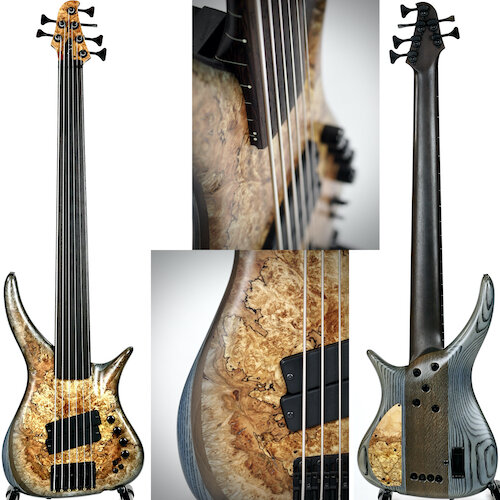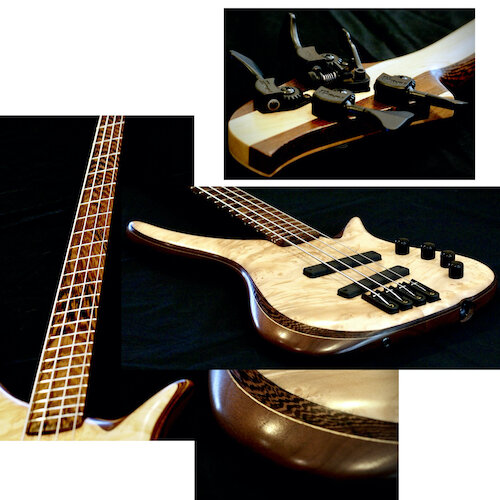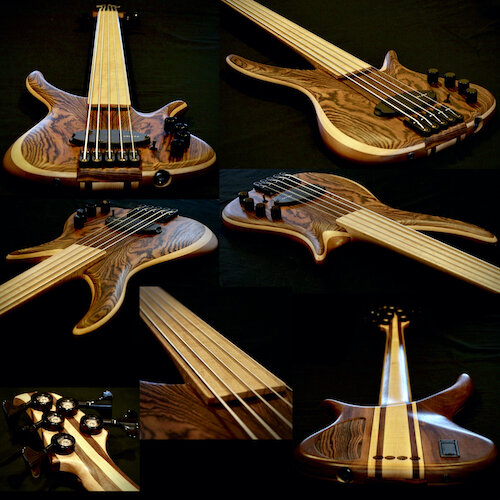Merlin
“Merlin” - another weird name, right? Let’s have a look at the magic behind it.
Well, you may be interested to know that this model originally was called “Kermit”. The prototype (see just below) features a VERY green back, and Kermit was quirky enough for me at the time. Until one day a customer told me he’d feel a little weird telling others he’s playing a “Polaris Kermit”. And fair enough. Instead he suggested to put a little bit of magic and me into it. And there it is, and I have to say I’m embarrassed not to have seen it myself: “EmMERLINg”. Gotta be happy with that!
I would happily say that Merlin combines the best aspects of various basses into my design philosophy: compact, ergonomic, organic and light. Of course all these aspects are interdependent.
The bridge (or single bridges) is positioned as closely to the end of the body as possible - that means there’s a potentially big reduction in reach (easier to get to the lower register).
Organic and extensive contouring means that there is far less material than on a “slab bass” without the need of chambering. Combined with the body shape this also means much easier access to the higher register.
Keeping the headstock as small as possible minimises or removes neck dive. It also reduces “advertising area” but I’m not as desperate as others 😉.
This approach is fully carried over to the “Sirius” and “Shorty” basses, and to some extent can be seen and experienced with the “B” and “Manta”. The result is a bass that doesn’t let you know it’s there, doesn’t get in the way, and hopefully becomes an extension of the player rather than an appendage.
But see for yourself.
Merlin prototype (a.k.a. “Kermit”)
The idea to build Kermit was conceived after I had been playing my Dingwall Z2 for a little while. It’s only my third build and I was happy to accept the challenge to go multi scale AND 6 string - which ultimately determined the design - at the same time. I would do a number of things quite differently today (that’s called learning, right?) but I think that Kermit overall has stood the test of time.
Of course the most eye-catching thing is the colour (thank you, David Searle!!). The green nitro over the grain-enhanced Northern ash with a silky oak centre is responsible for the name. A wenge layer separates the body from the spalted maple top.
The neck is one piece of wenge with dual action truss rod and 2 carbon rods and extends right up to the neck pickup. The ziricote board houses 24 frets plus a zero fret, as well as Luminlay side dots. The compound angle headstock is laminated with a matching piece of spalted maple, and for the first time I integrated my logo in the truss rod cover. Hipshot UltraLite Y key tuners and Hipshot Solo bridges mounted on a maple/wenge tone block round out the hardware.
The centre line of the two Nordstrand FD3 pickups is the scale-adjusted centre of a Stingray hum bucker. Each pickup can be switched series/parallel, and a 4-way rotary switch enables neck/both series/both parallel/bridge pickup selection. Onboard sound shaping is achieved with a Glockenklang 3-band preamp.
“Kermit” is in the more than capable hands of Finn Baulch. Examples of his playing and Kermit’s sound (most likely directly recorded and completely unprocessed) can be found on Finn’s YouTube channel.
Merlins galore
Over the years there have been quite a few Merlin builds with various hardware and electronic specs as well as different constructions. Here are some examples.
This 6-string 35” scale Merlin came straight after “Kermit”. Same body (northern ash with silky oak centre), walnut layer with spalted maple top. 1-piece wenge neck with unlined wenge board, and exactly the same hardware and electronics as Kermit.
The Nordstrand FD3 pickups are slanted (with the centre point at the scale-corrected centre of a typical MM hum bucker) to give more clarity in the lower register and a more mellow response for the higher register.
Another beastly Merlin. 5-string, 35” scale, walnut body, maple layer and Indian rosewood top. Neck is 3-piece maple with a maple board and an Indian rosewood heel block.
Hipshot UltraLite 3/8” Y key tuners and Hipshot Solo bridges are the hardware of choice. The Delano MC 5 HE/S-L EB pickup is in the scale-corrected MM humbucker sweet spot, can be switched series or parallel, and the signal is processed through a 3-band Glockenklang preamp.
This 35” scale Luminlay-lined fretless Merlin features a 7-piece neck (wenge and maple) and neck-through construction. The board itself is wenge.
The body is walnut with a layer of wenge and a beautiful amboyna burl top.
As usual you find Hipshot UltraLite 3/8” Y key tuners. The bridge is a 2-piece MK III by ETS. Just like with the 6-string fretless above the Nordstrand FD3 pickups are slanted for tighter bottom end and somewhat mellower treble (with the centre point at the scale-corrected centre of a typical MM humbucker) and can be switched series or parallel.
The Glockenklang 3-band preamp retains its original blend pot.
Oh look, it’s a 4-string! And it’s only 34” scale! So there, all these specs are possible - after all it is YOUR dream bass.
The three-piece neck (central maple with wenge) has Luminlay side dots, and the board is wenge with some crazy grain. This bass features the Xtend construction - the neck extends all the way to the neck pickup and (in this case) is secured with 6 M6 bolts. From memory this is my first commission build with EvoGold Mando-size frets.
The body is walnut with a layer of wenge and a natural quilted/flame maple top.
The Hipshot UltraLite 3/8” Y key tuners are complemented by a Hipshot Xtender for the E string. The bridges are Tuning Fork singles by ETS, and they’re recessed by about 2 mm.
In this case the customer had specific requests for pickups and electronics. The matched Bartolini X44CBJD pickups are mounted in the Warwick Thumb positions and feed the signs into a Bartolini 4.2AP preamp.
Another example of a fretless Merlin.
The 5-piece neck (maple and walnut) on this 35” bass has Luminlay side dots with black piping. To make sure you get the intonation right there are fret markers in the neck only - not visible from the front or on the board at all. The board is a beautiful piece of birdseye maple finished with Osmo Polyx 3032.
The body is walnut with a layer of maple, and the top is an amazingly figured book-matched example of bocote.
Adventurous as I am I tried different tuners for this bass - “steam punk”-looking Schaller “Da Vinci” which are fully sealed for eternal performance. They’re pretty light, too, despite their size. ETS Tuning Fork singles are the bridges on this bass.
The Delano Xtender 5 HE/S pickup is located in the scale-adjusted G&L bridge position and can be switched series/single/parallel. On-board tone shaping happens with a Glockenklang 3-band preamp.
One last example.
This 35” Merlin features a 5-piece neck (maple and purpleheart) with black-piped Luminlay side dots. The zebrano board has silver-nickel Mando-size frets.
The body is walnut with a layer of maple, and the top is a beautiful 2-piece purpleheart.
Back to the Hipshot UltraLite Y key tuners (3/8” post) with ETS Tuning Fork singles bridges.
Exactly the same electronics as for the bocote top Merlin just above: Delano Xtender 5 HE/S pickup located in the scale-adjusted G&L bridge position with series/single/parallel switch. On-board tone shaping happens with a Glockenklang 3-band preamp.
And here’s a video of me playing this particular bass (my main player) with “Doubleshot of Blues”:







